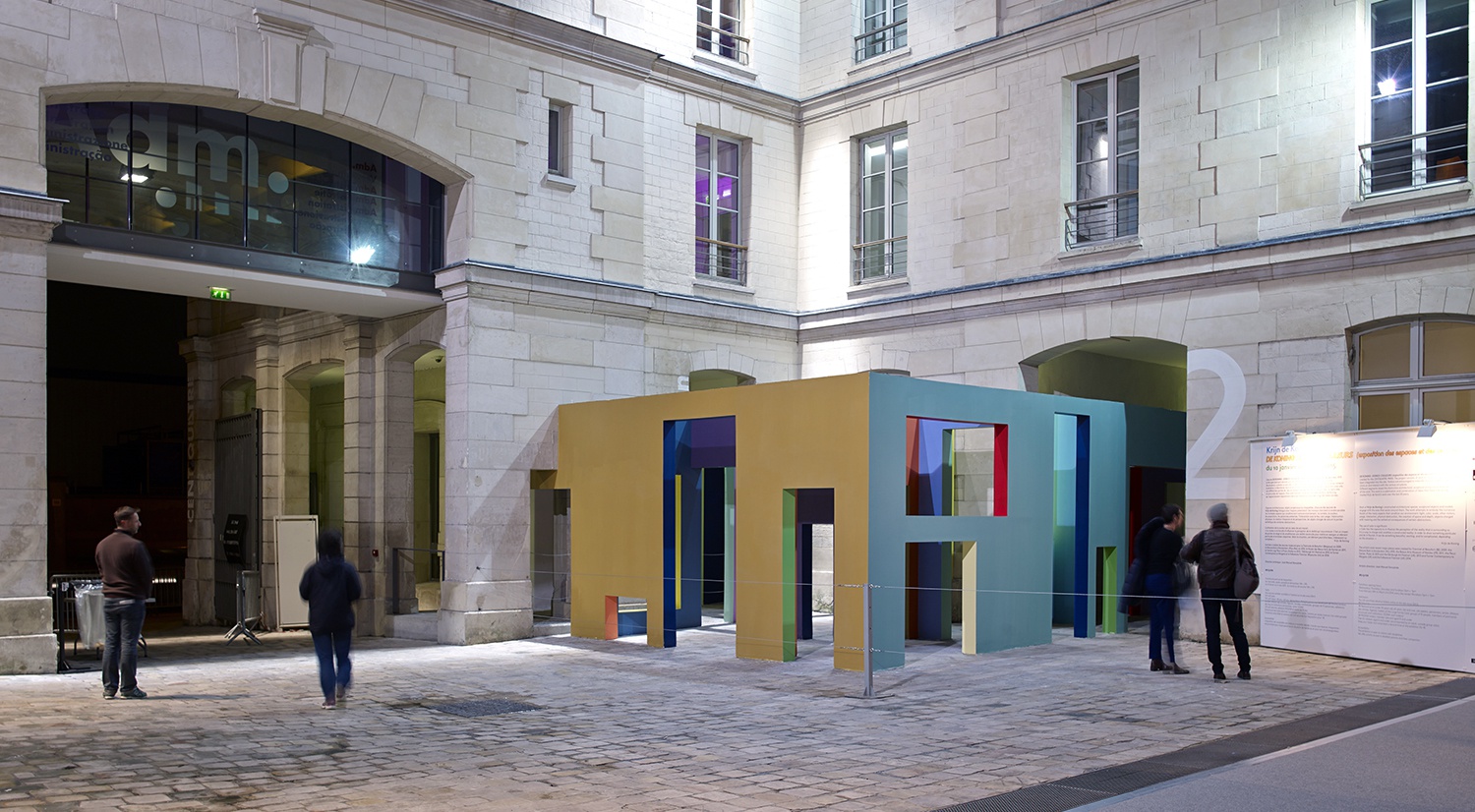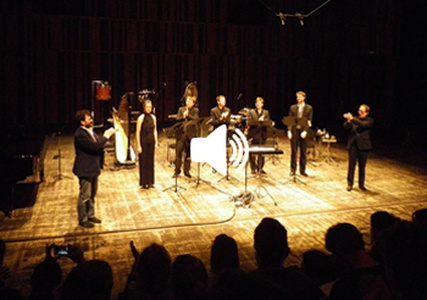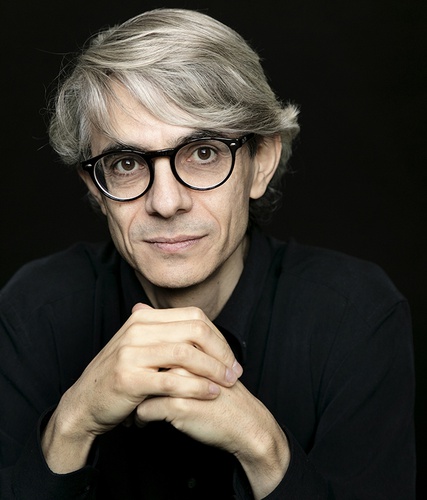Be it Goya or Mondrian, Alberto Posadas finds in painting, or in the visual arts, inspiration for the challenges of writing and musical interpretation. For the first time he begins a work in collaboration with an artist, making us aware of all that is fascinating and risky while wandering through the land of analogies.
Several of your works cite pictorial works as a source of inspiration. How does this analogy between visual and sound universes work?
There isn’t one reply to this question. My first work inspired by painting is Anamorphosis for ensemble, in 2006. For me, it is always about finding affinities, similarities between disciplines so that I can then find collision points and meeting points. From a phenomenological point of view, it is an empiric way to transfer certain phenomena from visual arts to inside sounds. For example, when we talk about sound, we often say something is dark or light—this makes it possible to understand—however this terminology isn’t adapted to sound but to light. When in the visual arts we say that something is dark, it means it absorbs the light, and when it is light this means it reflects a lot of light. But the equivalent in music would be dry or reverberant, a vocabulary we don’t use outside electronic laboratories. We use “dark” to simulate something that is beginning to lose details, but normally for a musician, something light is something very precise. This is not the case in the visual arts where something very, very bright causes us to lose the details. This mistaken relationship is a phenomenological approach.
There is another meeting point with visual arts that is attached to the artist’s underlying concept but it becomes my own reading of visual arts. Most of the time, I find a contact point through this perspective which is how I read visual arts. When I research this meeting point, it offers a large number of positions. The mechanism for production and that for perception are totally different.
Does the Sombras series also come from the visual arts?
 In the beginning, the idea came from a text by Cioran. The rest gravitates around the loss of detail and the redefinition. For me when I try to approach music and visual art or music and science, it is fundamental I am able to reach the problem I want to face. Concretely, I find several models that come from the visual arts. For example, in the case of Anamorphosis, my reference point was a portrait of Charles V by Lucas Cranach that is in the cathedral of Valencia. I discovered this painting when I was 8 years old. In this case, I used the process of the creation of an anamorphosis to control the evolution of the sound. In this case, there is a common technique that is works on questions on the signification of this technique. On one hand, the perception of an image, and on the other, the perception of sound. The way we create a visual anamorphosis is very clear; this is not the case with sound. There is an idea of distorting the perspective. A concept of harmony controlled by a topological distribution in space. In this case, the anamorphosis technique was a way to control this topological distribution of different points.
In the beginning, the idea came from a text by Cioran. The rest gravitates around the loss of detail and the redefinition. For me when I try to approach music and visual art or music and science, it is fundamental I am able to reach the problem I want to face. Concretely, I find several models that come from the visual arts. For example, in the case of Anamorphosis, my reference point was a portrait of Charles V by Lucas Cranach that is in the cathedral of Valencia. I discovered this painting when I was 8 years old. In this case, I used the process of the creation of an anamorphosis to control the evolution of the sound. In this case, there is a common technique that is works on questions on the signification of this technique. On one hand, the perception of an image, and on the other, the perception of sound. The way we create a visual anamorphosis is very clear; this is not the case with sound. There is an idea of distorting the perspective. A concept of harmony controlled by a topological distribution in space. In this case, the anamorphosis technique was a way to control this topological distribution of different points.
Everything is connected to issues of form in some way.
Yes, in this case, it was a question of form and structure. What is the relationship between these different sections of the piece and the different parameters of the music? But, for example in the case of Tres Pinturas Imaginarias, premiered at ManiFeste-2015, the first three movements “treat” the question of the sfumato technique. How to create a veritable perception of depth and light? I had to choose a type of material—musical or sound—to create that reality with the sound. It is less a common technique than a core technique. In the second movement, Variaciones perforadas sur un tema de Mondrian, I needed to know how to affront a graduated timing, just the way Mondrain used a sort of framework. I organized the perception of time based on frames, using a material as homogeneous as Mondrain’s colors. I connected to layers what could be divided, in a space for Mondrain, or that could divide the time in the case of the sound. Again, it is an underlying connection. For the third movement, Tachisme, it is again, very different. It was a challenge because I am used to working in a very formal manner. The musical material was launched in a very spasmodic way, a very direct gesture, and during the movement we had different shots and energetic gestures with sounds that “came” from nowhere.
All this goes back to the question of the perception of time and space. When this unpredictable sound appears for the first time, the direct effect is there. But, naturally, the second time we hear it, we have already begun a relationship with the sound.
But when music is a comparison with mass, as is the case in Magma for orchestra, you use control processes fairly close to those of Xenakis. In a certain way, the localized, direct gesture is no longer considered an element of a mass, and we are dealing with a stochastic phenomenon.
In Tachisme, precisely, I wanted to avoid using any models, any formalism that cold control, contrary to Magma. Maybe because after all these years of experience, I wanted to go in a new direction, not repeating the same process, to move to another place. What happens when we don’t have our standard tools? You have to invent a different path to find a solution to the problems.
Why, for a composer, is there the necessity to reference abstraction when imagining an articulation with the visual arts?
In music, we have the same problem as painters. We try to escape our own constraints be they temporal or spatial. This is why so many artists of the 20th century became so important to composers; they convey different perceptions of space. Most of my colleagues, composers, are inspired by abstraction and so am I. It is perhaps easier to face our own abstract problems than beginning with a figurative work but in my case, I am also inspired by Goya.


Krijn De Koning, view of the exhibit "Espaces-Couleurs" at the CENTQUATRE-PARIS, 2015 © Marc Domage
For the first time, you are collaborating with a living visual artist: Krijn de Konig. Can you tell us a little bit about this project?
It is still a little early to talk about it. I am writing 6 pieces for the 6 saxophones that exist, from soprano to bass, and these pieces are imagined in relation to poems, including one by José Ángel Valente. I had the idea of leaving the normal concert situation to create a situation where the listener would be more involved or captive in his listening. I suggested to Krijn de Konig to work using only one instrument. He will build the structures (we don’t know how many), and each piece will be played in a different space-structure. At certain times, we will hear the poems. The project is to give the public—a small number of listener-visitors so that each one can move around—a notebook with a few sketches by Konig, a few examples of my score, excerpts from the poems, and blank pages. They can write on the blank pages throughout the performance. At the end, we ask the audience to trade their notebooks.
Certain saxophones used in the piece will be transformed with the idea of what I call “micro-instrumentation” and that consists of exploring microscopic intervals. For the sopranino, for example, for the first time I used a mute. It is very surprising; we obtain multi-phonic effects and can easily produce pulses. I am researching this with the instrument and it would be interesting to carry out the same kind of scientific research to explain how we get these effects. The mute only tempers the sound, which is not the aim; it acts like a bass filter. These are acoustic phenomena that join the electronic sounds. For me like other composers of my generation, electronics are a huge influence. They modified my work with sound entirely. Even for works “without electricity”, electronics are present.
By Patrick Javault, art critic
Photo 1: Alberto Posadas © Harald Hoffmann / Ed. Durand
Works by Alberto Posadas
Linked events
Linked contents
Alberto Posadas
Composer (b. 1967)
In 1988, Alberto Posadas met the composer Francisco Guerrero, who he considers to be his true master. With him, Posadas explored new forms using cominatory and fractal techniques...









